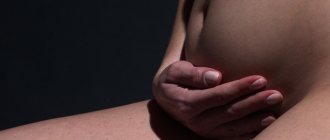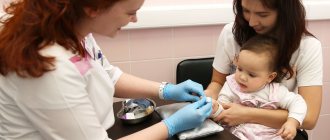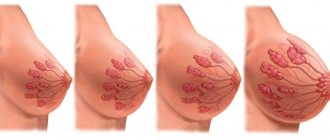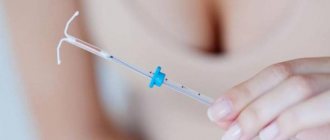There is an opinion that in order for milk to come in faster and not stagnate, you need to express your breasts. Is it necessary to express colostrum and how to do it correctly? We'll talk about this in today's article.
The release of colostrum in pregnant women is a normal natural process. Although its absence is also not a deviation from the norm. In some pregnant women, it begins to secrete in the first trimester of pregnancy. Others notice the arrival of colostrum only after childbirth. It should be noted that there is no direct relationship between the amount of colostrum during pregnancy and the amount of breast milk during breastfeeding. The abundant secretion of colostrum during pregnancy does not at all guarantee a woman the absence of problems during breastfeeding.
When and how should colostrum appear?
A woman's breasts are preparing for the future feeding of a child from the very moment of conception, but during the first weeks and even months of pregnancy this may not be noticed. Colostrum is formed in small quantities and most often is not released out into the first trimester. But for some women, especially those who have already given birth, fluid discharge from the mammary glands may be the first sign of pregnancy.
In the second trimester, colostrum begins to form more intensively. It leaks out and expectant mothers begin to notice stains on their underwear. While they appear occasionally, but by the third trimester, most women begin to secrete colostrum almost constantly. The mammary glands are ready for the birth of a child. After birth, colostrum continues to form for another 3-7 days, and then is replaced by mature milk.
Colostrum production during pregnancy is enhanced by the following factors:
- breast massage;
- stress;
- hot shower;
- hot drink;
- prolonged sexual intercourse.
The physiological norm for the appearance or non-appearance of colostrum during pregnancy is very wide.
In some women it does not flow at all. This does not mean at all that their breasts are not preparing for lactation and there will be no milk. The fluid simply fits inside the breast and there are few factors that provoke its release. The appearance of colostrum already in the first days of pregnancy can also be considered normal. Sometimes the fluid coming from the nipples may be pinkish in color from blood. This is due to the expansion of the ducts and the rupture of small capillaries as a result.
During pregnancy, your breasts may feel a little itchy. This is absolutely normal. This is a sign that the mammary glands are growing in preparation for lactation, and the skin is stretching. In this case, you can use a stretch mark cream to prevent the formation of scars, which look very unsightly.
How to Express Milk
After preliminary preparation of the breast in the form of warming up the breast, it remains to decide what will be used for this. For the process of how to settle after childbirth, this choice is of fundamental importance. The easiest way is with a breast pump, to use which you just need to press the silicone nozzle against your breast tightly enough to create a pump effect. At first, pumping may be painful due to breast fullness, but later this process is quite fast, convenient and effective. It is somewhat less convenient to express milk manually, although here everything depends on the individual preferences of women: some like breast pumps, while others do not, so it is not very correct to compare without trying both methods. Express the breasts with your hands using smooth movements, constantly massaging them from top to bottom towards the nipple. Do not put pressure on the nipple or areola, squeeze or exert any other physical force, as this can lead to blockage of the ducts.
Conditions when consulting a doctor is necessary
- A lot of blood comes out of the nipples. At the same time, the chest and possibly the stomach hurt. This condition may indicate the development of an inflammatory process or neoplasm in the mammary glands, and may also be a harbinger of premature birth. This is why you should definitely tell your doctor if you have any bleeding from your nipples.
- The release of colostrum is accompanied by chest pain. It is imperative to visit a doctor, as this may mean that the woman has mastitis. Treatment is urgently needed to avoid intrauterine infection of the child. If the baby is about to be born, then treatment is also very important. A child should not eat contaminated milk.
- If, in addition to the release of colostrum, a woman feels pain in the lower abdomen or in the lumbar region, then this indicates increased tone of the uterus. This condition is caused by increased levels of the hormone oxytocin and can lead to premature birth. To prevent such developments, hospitalization is required.
Features and tips for feeding during colostrum
Many women think that large breast size a priori leads to abundant lactation. However, this is not entirely true. It is important to teach your baby how to properly grasp the nipple, choose a position and position for feeding that is comfortable for you and the baby. Mother's milk, and initially colostrum, not only serves as the main nutrition for the newborn, but also calms the baby and helps him adapt more easily. It is also the key to the child’s full development in the future. Therefore, mothers often need additional time to establish contact with the baby.
For successful long-term lactation, a woman needs to put her baby to her breast as often as possible in order to develop colostrum and promote the early appearance of full-fledged milk.
You should feed your baby on demand, at least 9 times. In this case, it is worth choosing a comfortable position - you can feed the newborn lying on your side or sitting. Give alternately to each breast at one feeding.
If the baby resists and does not take the breast, then the reason may be the incorrect shape of the nipple. You need to do everything possible to maintain lactation, so you should try feeding your baby using special nipple shields. It is important to monitor the diet of a nursing woman and maintain a drinking regime.
The importance of colostrum for a newborn
- Colostrum saturates the child’s body with immune cells. The child’s own immune system develops gradually and begins to function fully by the age of approximately 6 months. In mature milk, the concentration of factors important for immunity is significantly lower, which is why it is so important that the child receives a sufficient amount of colostrum.
- Prevents the development of jaundice by binding excess bilirubin.
- Promotes the maturation of the intestinal epithelium, prepares it for the digestion of milk, and promotes the removal of meconium.
- Populates the intestines with beneficial microflora and prevents harmful bacteria from multiplying.
- Helps adapt the respiratory system by saturating the blood with antioxidants.
Beneficial properties of colostrum
The importance of colostrum for a baby is difficult to overestimate, because the translucent secretion of the mammary glands performs the following functions:
- Immune - in the fluid that is secreted by the breast, there is a significant amount of proteins that provide protective mechanisms against infectious pathogens.
- Formative - ensures the colonization of the intestines with beneficial bacteria, which will help in the absorption of food, the formation of normal bowel movements and prevent the proliferation of pathogenic bacteria.
- Conjugate - colostrum secretion binds excess amounts, which prevents development.
- Nutritional – provides the body not only with the necessary nutrients, but also stimulates the division of cells in the epithelial layer of the intestine, which is so important for the further full existence of the child.
Breast hygiene for the expectant mother
The release of colostrum does not require any special procedures. Breast care falls within the framework of normal hygiene with only minor additions.
- Most importantly, colostrum should not be squeezed or expressed. Firstly, it increases its quantity, and secondly, it increases the tone of the uterus. In the best case, pumping will lead to the onset of lactation before birth, and in the worst case, the baby will be born prematurely.
- A bra should be worn that is supportive but not constrictive. As your breasts grow, you need to move up to the next size.
- The mammary glands should be washed with clean water without using gels or soap 1-2 times a day. It is necessary to place cotton pads between the nipples and the bra and change them regularly, especially if the fluid flows heavily. This will help prevent bacteria from multiplying in the nutrient medium such as colostrum.
- You should use soft towels and just blot your nipples with them without rubbing them. If microcracks form in the nipples, then a direct path to infection will be opened. To prevent cracks from appearing, it is advisable to use moisturizing creams.
Colostrum is produced in all women during pregnancy. But not everyone has it leaking from their nipples. It must be remembered that the norm is the release of colostrum from the first weeks of pregnancy, and its complete absence until childbirth. In order for your breasts to be healthy when your baby is first latched, you need to take proper care of them. And in order not to cause an increase in uterine tone, do not squeeze colostrum from the breast.
The breasts fill up in anticipation of the start of the lactation period, the ducts expand and over time a yellowish liquid similar to milk appears in them. During the period of bearing a child, it is strictly forbidden to squeeze out colostrum. The reason for the ban and when you can express milk from the breast will become clearer later.
Is it possible to express or squeeze out colostrum during pregnancy?
In general, obstetricians and gynecologists reassure all pregnant women: this phenomenon does not pose any dangers or problems, as long as you properly care for your breasts during this period and under no circumstances squeeze anything out of them.
There are several main explanations why colostrum should not be squeezed during pregnancy:
- Any breast stimulation during pregnancy promotes the production of the hormone oxytocin, which tones the uterus and triggers its contraction mechanism. That is, such manipulations can cause miscarriage or premature onset of labor.
- The more you stimulate the release of colostrum from the breast, the more it will be produced, which will only worsen the situation.
- The surface of the nipples never remains sterile clean. There is an opinion that by squeezing out colostrum, you can easily introduce an infection inside the mammary glands.
As for breast care, if colostrum leaks during pregnancy, it comes down to simple rules:
- Every day (at least morning and evening), wash your breasts with warm water from the shower without using detergents.
- Wear a comfortable bra - with a deep cup, strong wide straps, without unnecessary seams or decorative elements. The bra should hold your breasts securely, preventing them from moving excessively, but not squeezing them or causing any other discomfort. The bra should be regularly replaced with a new one and ensured that it remains dry: a warm, humid environment promotes the growth of bacteria.
- If the discharge is abundant, then it is better to use special breast pads or put cotton pads in the bra cups.
Finally, we note that there is no connection between the release of colostrum during pregnancy and the production of breast milk after childbirth. There are various myths among people about this, supposedly:
- The appearance of colostrum is one of the first signs of pregnancy.
- If colostrum is released during pregnancy, labor will begin soon.
- The more colostrum is released during pregnancy, the more breast milk will be produced later.
But all these opinions are wrong. Whether colostrum is released during pregnancy or not, this in no way affects the future feeding of the baby.
Especially for - Larisa Nezabudkina
Colostrum is a common occurrence if a woman has recently given birth or is just at the stage of pregnancy. But what should you think if the test is negative, and before your period there is discharge from the breast? It happens that this indicates a change in hormonal levels or from taking pills. However, if you have no reason for discharge, should you consult a doctor? This is due to many reasons.
Reasons for the ban
The breast begins to prepare for feeding the baby long before he is born. In the first weeks of pregnancy, no discharge appears, but starting from the second trimester, colostrum appears.
Is it possible to squeeze out colostrum during pregnancy? No. Many pregnant women begin to notice small yellow spots on their underwear, and most of them, to the best of their ignorance, try to squeeze out colostrum. Women do this in order to understand the reasons for the appearance of unknown discharge from the breasts, and this should not be done under any circumstances.
Why you should not squeeze out colostrum:
- it is possible to provoke a miscarriage;
- the action tones the uterus, which in recent weeks can cause premature birth;
- infectious inflammation is likely to occur due to the sweet environment of milk fluid;
- Cracks appear on the nipples.
Therefore, you should not squeeze out colostrum during pregnancy. It can really harm the body, as well as provoke problems with the development and birth of the baby. It is necessary to take care of the mammary glands to protect them from unwanted problems.
Features of breast hygiene during pregnancy:
- It is not recommended to express colostrum during pregnancy, so as not to injure the nipples and not contribute to an increase in milk production ahead of time;
- do not squeeze your breasts with tight bras, they should have a supporting effect;
- You need to wash your breasts with warm water 2-3 times a day, but without detergents;
- If colostrum is abundant, it is necessary to use special pads for nursing mothers.
It is necessary to understand that the formation of colostrum is an absolutely normal phenomenon during pregnancy. Therefore, there is no need to panic due to discharge, unless it is accompanied by pain in the lower abdomen, pus or has a reddish tint, then you should consult a doctor immediately.
Everything is individual for each woman, so if there is no colostrum formation before childbirth, there is no need to worry - it will appear after the birth of the baby.
Let's summarize
Many people mistakenly believe that the baby is not getting enough colostrum and start pumping to increase the volume of secretions. However, this opinion is wrong. Colostrum is a very valuable and nutritious product. It contains substances that provide strong immunity to the child for several months of life. In addition, in the first days after birth, the baby’s gastrointestinal tract is just beginning to function, and the amount of colostrum is quite enough to provide the baby’s internal organs with the necessary (but not more!) load.
It is also worth noting that expressed colostrum should be fed to the baby immediately. It cannot be stored for a long time even in the refrigerator, so the question of constant pumping disappears by itself.
In any case, it should be borne in mind that sites on the Internet can only give some recommendations. But if you have any problems or questions about breastfeeding, you should contact a specialist so as not to risk your health or the health of your baby.
The use of squeezing after childbirth
Not all women begin to produce colostrum during pregnancy. It happens that the baby has already been born, but the mother does not yet have milk, or there is too little milk for proper feeding. Such women in labor need to try hard to establish the lactation process as quickly as possible; only in this case can squeezing be used to normalize colostrum production. You need to follow certain recommendations so as not to injure your breasts and express the first drops.
How to properly squeeze out colostrum after childbirth:
- wash your hands thoroughly or treat them with an antiseptic;
- place the fingers of the opposite hand on the chest in the place where the areola and normal skin connect;
- you need to direct the movement towards the chest, pressing on the milk ducts;
- It is important not to rub the wounds on the mammary glands, otherwise the process of feeding the baby will turn into real torture.
To improve breast milk production, it is necessary to use all known methods that are allowed to be used. In this case, you need to try not to harm either the breast or the baby.
It is very important not to miss a moment and squeeze out at least a few drops of colostrum in order to strain and fully feed the newborn.
First, you should try self-massage of your breasts. Such manipulations stimulate the production of colostrum. If possible, it is advisable to take a warm shower; it will also have a beneficial effect on the appearance of milk fluid in the first weeks of feeding. If massage does not bring results, you can use herbal tea to increase lactation. A certain set of herbs will contribute to the rapid development of the feeding process.
Such methods are gentle; if they are not effective, it is necessary to use special medications that increase milk production. This should be a last resort, only if all natural methods of influencing the mammary glands have been taken, because the tablets penetrate into the milk and cause harm to the baby.
Baby suckling at the breast is the best and safest stimulation of milk production. Correct and frequent feeding will help to establish lactation in the first days of a newborn’s life. Do not despair if you cannot immediately achieve a positive result. The baby can return to the breast after bottle feeding. It is recommended to start using mixtures only when everything possible has been tried.
It is clear that squeezing out colostrum by force is unpleasant, painful and difficult, but there is no better nutrition than mother’s milk. Therefore, the main task of the mother is to ensure adequate breastfeeding, no matter what.
Squeezing out colostrum is allowed only after childbirth, when this procedure is simply necessary. During pregnancy, it is strictly forbidden to carry out such activities, because it can provoke drowning of the uterus and, as a result, premature birth.
During pregnancy, a woman’s body is radically restructured not only to carry a fetus, but also to subsequently support the newborn. One of the important processes is lactation. The mammary glands change their structure, shape and size, and droplets of colostrum may appear from the first weeks. It is important to know how this process occurs normally in order to detect pathology in a timely manner.
Colostrum is a concentrate of nutrients and vitamins. It is extremely important for the baby in the first few days of life. Then the composition of the secretion changes and the usual breast milk appears.
When to really pump
Gone are the days when doctors recommended squeezing out the last drops of milk from the breast after feeding the baby, thus preventing the occurrence of mastitis. Breastfeeding specialists, and along with them progressive doctors, believe that the breast cannot be considered a “vessel” full of milk. To a greater extent, this is the “source” from which milk comes during the stimulation process. Therefore, an attempt to express everything can only lead to hyperlactation, whereas in fact it is necessary to express in completely different cases:
- before feeding the baby, if he cannot take the nipple due to overcrowding in order to facilitate latching;
- after feeding, if the feeling of heaviness and soreness continues to bother you, and the baby cannot cope with the available volumes of milk;
- if necessary, make a “reserve” when the mother leaves for several hours and the child must be fed by relatives;
- if you want to increase the amount of milk, although this theory is quite controversial and there is an opinion that not a single breast pump can compete with the child, since it is not a matter of the quality or frequency of pumping, but of the hormone that is produced precisely when the baby is applied to the nipple. Therefore, among the leaders among the answers to the question of how to develop breast milk after childbirth, it would hardly be correct to put pumping in first place.
Well, the most common reason is lactostasis, also known as stagnation of milk in the breast, which often occurs not only during the development of lactation, but throughout natural feeding.
The benefits of the secret
Thanks to the active work of prolactin, during gestation the ducts and tubules of the breast expand and the formation of a sweetish viscous liquid of white, grayish or yellowish color with a specific odor begins. The closer the moment of birth, the less intense the color becomes.
This is a very fatty natural product with a complex chemical composition. Its calorie content per 100 ml is almost 150 kcal, and its density is more than 1.1.
Women's secretions contain up to 85% water, which helps the baby easily get rid of accumulated meconium - original feces. The special properties of the liquid also protect the newborn’s kidneys from overload. Chemically, the secretion is closer to human blood than to breast milk. In addition to water, it contains:
- proteins - a lot of easily digestible globulins and albumins with a low content of casein and lactose;
- enzymes - carbohydrase, peptidase, catalase and esterase.
And also in large quantities:
- vitamins, mineral salts;
- natural antioxidants;
- lacto- and bifidobacteria;
- hormones (including endorphins);
- leukocytes.
This composition not only protects the baby’s delicate body from infectious diseases, but also protects against stress, providing endurance. In addition, it helps the child’s digestive system, which is not yet fully strengthened, to properly absorb nutrients, protects the body’s cells from pathogenic microbes, stimulates DNA synthesis, and removes excess bilirubin.
Pathological secretion of the mammary glands during pregnancy
The amount of colostrum released does not affect the secretion of breast milk in the future, because these are completely two different processes that do not depend on one another, have different influencing factors and even hormonal ratios.
The appearance of this fluid in the mammary glands of pregnant women is a preparatory stage for breastfeeding. Colostrum is released as a natural result of hormonal changes in the female body. When does a woman notice his appearance for the first time? What does she need to know about this substance?
What is colostrum
The very name of the liquid indicates its connection with breast milk. It appears under the influence of the female hormone oxytocin. People call it young milk. Its appearance is preceded by an enlargement of the pregnant breast and an increase in its sensitivity. It is during this period that the tubules and ducts of the mammary glands expand.
Colostrum is a sticky, viscous, sweetish liquid. Its color may be yellowish and translucent. The main component of the nutrient fluid is albumin. This protein helps the baby develop. In addition to albumin, colostrum contains globulins, fats, mineral salts, bifidobacteria and lactobacilli, lactose, vitamins A, C, E, PP. The substance also contains amylase, protease, lipase - food enzymes. The basis of the nutrient fluid is water. It contains about 84% of colostrum. The calorie content of the liquid is 150 kcal per 100 ml.
Dates of appearance and quantity
From the beginning of the 13th to the end of the 30th week, a woman may notice the appearance of yellowish sticky spots on her clothes, which become more intense regardless of the time of day. The amount of liquid released usually varies from one drop to 5 ml. From the 30th week until birth, colostrum is released in varying quantities, but the liquid loses its color intensity, while maintaining its chemical composition. During pregnancy, many factors can affect the functioning of the mammary glands. For example:
- outbursts of positive emotions or stress;
- sexual intercourse;
- hot shower;
- massage;
- drinking strong tea, coffee, alcoholic beverages.
Expectant mothers, especially during their first pregnancy, are anxious about a small amount of breast secretion or the fact that it sometimes dries out. No need to worry. But you should not put pressure on the chest, stimulating fluid production. This can cause a surge of oxytocin and provoke uterine tone.
Alarming symptoms
The process of formation and release of colostrum is approximately the same for all women. But sometimes a small amount of blood is detected in the secretion. This is not always an alarming symptom, but you should consult a doctor.
Often in the period from the second to third trimesters, a pregnant woman begins to feel itching and bloating in the chest. There is a feeling as if something is pressing from within. This is due to the growth and differentiation of the ducts and is considered normal. The body itself sends alarm signals when any pathologies occur.
- Pain with discharge from the chest. May indicate the presence of inflammation of the mammary glands. To avoid purulent mastitis and subsequent infection of milk, you should undergo a course of anti-inflammatory treatment after examination by a doctor.
- Pain in the lower back, sacrum or lower abdomen. Possible evidence of uterine hypertonicity and threat of miscarriage.
- Copious bleeding. A variant of the symptoms of benign and even malignant neoplasms.
- Unpleasant smell of secretion. A probable sign of the development of infection in the mammary glands. At the same time, the woman feels weakness and nausea. Timely antibiotic therapy is necessary.
Can colostrum be released without pregnancy: why does it appear?
It is very important to remember the fact that without pregnancy (or if there was no pregnancy before), the release of colostrum is impossible. Any fluid that is released should be examined by a doctor to rule out any possible illnesses.
Sometimes colostrum manifests itself due to the fact that a woman’s hormonal levels have changed or she has taken contraceptive medications. The doctor, in turn, will first prescribe all the necessary tests in order to determine the amount of hormones that cause colostrum.
However, before you start worrying, take care to rule out natural causes.
Namely:
- Perhaps you have recently breastfed and the colostrum is residual secretion;
- You are pregnant, but your pregnancy is too early to be determined by a test.
If all the causes have been eliminated or not detected, then we will talk about a disease that is inflammatory in nature or even a tumor (malignant or benign).
Rules of care
There are no special recommendations for breast care when colostrum is released. Simple rules of hygiene must be observed.
- Wash your breasts. Water procedures are carried out several times a day with warm water. Soap is not used to avoid microcracks. You need to wipe (or better yet, blot) with a soft cotton towel.
- Choose the right bra. It should fit perfectly to the size and shape of your breasts. The product should not rub or squeeze. Buy underwear made from natural materials.
- Use cotton discs. If there is a lot of colostrum being released, you can use linen inserts. But you need to change them more often to avoid infection.
- Do not massage your breasts. And do not try to express the secretion before childbirth, so as not to provoke uterine tone.
- Eat properly . It is useful to reduce the consumption of carbohydrate-containing products (products made from high-grade wheat flour, sweets, potatoes, rice and semolina), and introduce more vegetables and fruits into the diet.
In case of pain, the formation of pathological impurities in the secreted secretion, or a sharp enlargement of the mammary glands, it is recommended to immediately consult a gynecologist.










